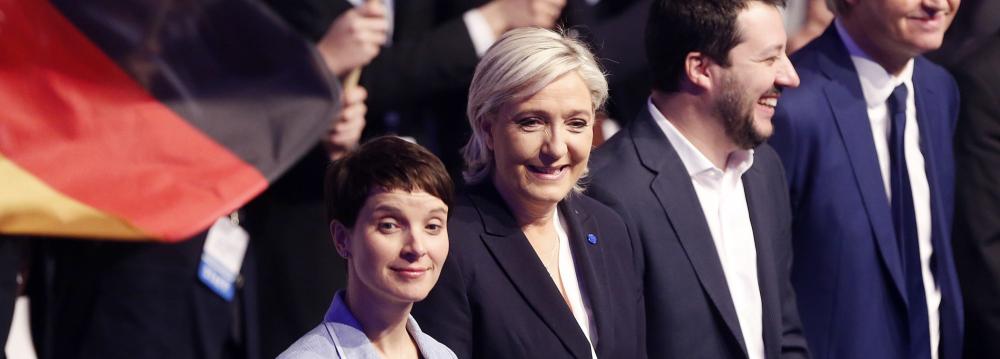The rise of the far right was a defining feature of European politics in 2017.
In December, the trend peaked with Austria becoming the only European country to bring the far right into government, David Child writes in Al Jazeera.
Several parties have exploited discussions about immigration, Islam and the role of the European Union, considering them a threat to security, to win support, from France to Poland.
“The far right didn’t put immigration on the agenda, the refugee crisis did that,” said Cas Mudde, an expert on far-right politics at the University of Georgia. “If we didn’t have a far right we would have been talking about immigration and Islam, but they have had a very important [role] on how we talk about those things.”
Far-right movements, he said, are defined by “nativism, authoritarianism, and populism”.
“Brexit and Trump set up 2017 as the year of populism and the radical right,” he said. “There’s still this broad understanding that radical rights are flash parties —they come out of nowhere, get big success, shake up the system and then disappear— that is empirically just not true for a lot of them.”
This year, the far right heavily influenced mainstream parties, which feel threatened by the growth of populist parties.
“When mainstream parties take over the agenda of the radical right, even if they don’t implement the policies, they are saying the concerns are legitimate,” said Mudde.
With elections to continue in Europe in 2018, change is needed, said Pietro De Matteis, vice president of the pan-European citizens’ movement, Stand Up for Europe.
“Europe has to reform, and reform around and with the citizens. I hope 2018 is the time when this will start.”
Below is a review of the outgoing year.
January: Far-Right Leaders Meet in Germany
Leaders of Europe’s far right, including Marine Le Pen of France’s National Front and Geert Wilders of the Dutch Party for Freedom (PVV), convened in Germany’s Koblenz on January 21 under the auspices of Europe of Nations and Freedom (ENF) —the smallest political group in the European Parliament.
At least 3,000 protested against xenophobia as the meeting took place. Speakers hailed the election of US President Donald Trump and Britain’s Brexit vote as victories for their cause.
Le Pen told attendees: “In 2016, the Anglo-Saxon world woke up … In 2017, I am sure that it will be the year of the continental peoples rising up,” she said.
March: Far Right Boost in Hungary, the Netherlands
In Hungary, Janos Ader was reelected as president on March 13.
He is a member of the ruling conservative Fidesz party, which has shifted further right, in part due to a campaign against billionaire investor and philanthropist George Soros, whose Open Society Foundations (OSF) charity advocates for greater acceptance of refugees and migrants.
In the Netherlands, the March 15 general election saw Geert Wilders’ PVV party win the second-largest share of votes with more than 13% overall and a five-seat gain on the 2012 election. Mark Rutte, the Dutch prime minister, held on to his role.
May: Le Pen Eyes French Presidency
France’s National Front leader Marine Le Pen made it to the second and final round of the French general election on May 7.
The party took more than 10 million votes —a record performance— but Emmanuel Macron won with 66%.
September: Alternative for Germany Surges
Germany’s Alternative for Germany (AfD), which promised to ban all mosques and criminalize wearing the veil, emerged as the country’s third biggest political force, winning 12.6% of the popular vote on September 24.
Angela Merkel’s center-right Christian Democratic Union party secured 33%, down almost 9%from the 2013 ballot.
“Had Merkel scored 3 or 4% more we would all be talking about the end of populism and the new energy of liberal democracy,” Mudde said.
October: Gains in Austria
Austria’s Freedom Party (FPO), led by Heinz-Christian Strache, won 26% of the vote, becoming the third largest party, in the country’s October 15 election.
It entered government in December, forming a coalition with 31-year-old Chancellor Sebastian Kurz and his Austrian People’s Party.
Both parties campaigned for tougher immigration rules and the deportation of asylum seekers.
November: Fascists Join March in Poland
Some 60,000 people, including nationalists and fascists, took part in Warsaw’s Independence March on November 11.
The demonstration carried a clear anti-Islam and anti-EU message.
“We know that politics led by extremists is a recipe for disaster,” said Matteis of Stand up for Europe.
“We have had two world wars in the last century; we don’t want conflict again ...Together we need to draft a new vision for the future of Europe, battling the problems people see as only being addressed by the populists.”


